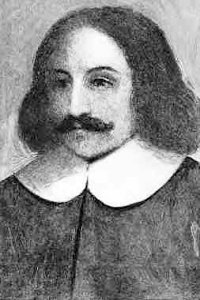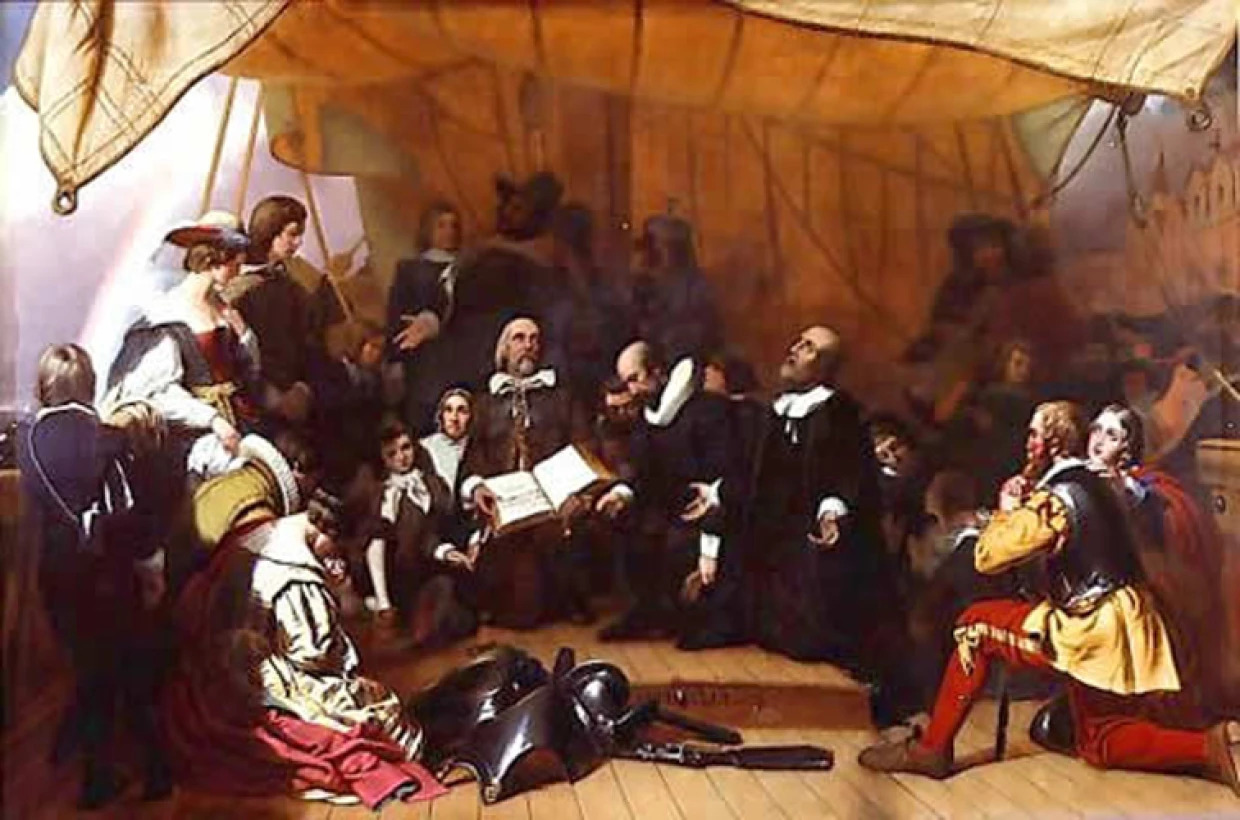Of the roughly 100 pilgrims that joined the Mayflower voyage and founded the Plymouth Colony, William Bradford stands out. After leaving his England home as a teenager in pursuit of religious freedom, he later became a leader in one of the most famous colonies in what later became the United States.

What Is William Bradford Known For?
William Bradford was one of the original settlers of the Plymouth Colony after leaving England on the Mayflower in 1620. Bradford was influential in shaping Plymouth’s government and became its governor in 1621. He went on to serve as governor off and on for over 30 years.
After his years of service, Bradford left behind a successful and thriving colony that would later be assimilated by Massachusetts. He is also known for his invaluable journal called Of Plymouth Plantation, which offers a detailed account of Plymouth Colony’s early stages and the lives of the Mayflower pilgrims.
William Bradford: Early Life and Religious Beliefs
William Bradford was born in Yorkshire, England, in circa 1590. This birth date and location is based on his baptism record, which shows he was baptized on 19 March 1589/90 in Austerfield, Yorkshire, England.

When Bradford was 12, he started attending the church services of Reverend Richard Clyfton, an English Protestant Separatist. There he learned of efforts to reform the Church of England and end all remaining Roman Catholic practices within the church. Bradford kept coming back and eventually formed a close relationship with William Brewster, of nearby Scrooby Manor.
Religious Persecution
When King James I took the throne in 1603, he started cracking down on reform movements. Reverend Clyfton’s congregation of about 50, including Bradford, started meeting in secret at Scrooby Manor. By 1607, they were discovered by the Archbishop of York. Many of them were imprisoned, fined, or watched around the clock.
Fleeing to Holland
Hoping to avoid further persecution, the Scrooby congregation decided to leave England illegally and go to Holland, where laws were more flexible. On their first attempt to leave, William Bradford and others were arrested and imprisoned after their ship captain betrayed them. By 1608, however, they made it to Holland and continued to worship together.
William Bradford and the Mayflower
After 10 years in Holland, Bradford and the Scrooby congregation were afraid of losing their English language and cultural heritage. Together, they decided to negotiate permission to settle in the New World, eventually making arrangements to settle in the Virginia Colony. By 1620, all preparations were made, and the group departed.

Originally, the Mayflower was intended to sail alongside a ship named Speedwell. The Scrooby congregation set sail on the Speedwell, but misfortune struck, and the ship soon began to leak. Both ships returned to port, and the pilgrims boarded the Mayflower alongside another group of settlers to depart yet again in September 1620.
Bradford and the rest of the pilgrims spent two long, cramped months at sea in stormy waters. In November, they were thrilled to spot the coastline and landed in Cape Cod, Massachusetts.
The Foundation of Plymouth Colony
The Mayflower was supposed to arrive in Virginia, where the pilgrims had a charter allowing them to settle. However, the stormy seas shifted their course north, landing them in Massachusetts. Passengers soon started arguing about what to do since the charter was no longer valid.
The Mayflower Compact
The threat of mutiny became apparent, so William Bradford and about 40 other men wrote and signed the Mayflower Compact in November 1620. Under the Mayflower Compact, the pilgrims agreed to work together to form laws and start a settlement. It became the foundation that later helped the pilgrims establish a government.
After multiple expeditions onto land, the pilgrims found the perfect site for Plymouth. In previous years, it had been the site of a Patuxet village before the Patuxet people were wiped out by a plague between 1616 and 1619. There were already fields for crops and water nearby.
Harsh Plymouth Winter
In December, Bradford and many others started to build the first homes for the pilgrims. Inadequate shelter and food throughout the winter made progress slow. Many pilgrims fell ill, Bradford included, after collapsing on January 11. He made a miraculous recovery, but not everyone was so lucky. By the end of the first winter, half of the pilgrims had perished.

William Bradford as Governor
The first governor of the colony was John Carver. Carver was able to form peace treaties and alliances with Native American tribes, but he died shortly after. Following Carver’s death, William Bradford was elected as the governor of Plymouth, an office he held for most of the remainder of his life.
As governor, Bradford played an active role in the colony’s finances, trading, courts, laws, and relationships—basically, he had his hand in pretty much everything. He established democratic practices, such as town meetings that served as the first example of self-governance in the New World. These practices would later help shape national politics in the United States.
Furthermore, he made a point of welcoming all religious pilgrims to Plymouth as well as nonbelievers. He also proclaimed the first Thanksgiving, a tradition we still celebrate today.

William Bradford and 'Of Plymouth Plantation'
Over a number of years, William Bradford wrote Of Plymouth Plantation, detailing the beginnings of the Plymouth Colony and the lives of the Mayflower pilgrims. He started writing the journal in 1630, which eventually covered the years 1620 to 1646.
Of Plymouth Plantation quickly became recognized as a great literary work, both for its detailed history and for Bradford’s ability to tell stories. It has long been regarded as an American classic. It is also considered to be the best source of information on the beginnings of the Plymouth Colony.
The manuscript went missing in 1780 during the British occupation and later appeared in a London library. American officials made multiple attempts to reclaim the manuscript. They were unsuccessful until the British eventually relinquished it in 1897.
William Bradford’s Death
William Bradford died on May 9, 1657, after nearly 40 years in the Plymouth Colony. Bradford had been sick for several months and even told his friends and family that he would die. True to his word, he died the very next day, at the age of 68. He was buried on Burial Hill in Plymouth, along with many of the original Mayflower pilgrims.
William Bradford Descendants and Family Tree
William Bradford’s legacy lives on today, not only through his writing and the impact he had, but also through his descendants.
William Bradford married Dorothy May in Amsterdam on December 10, 1613. Together they had one son, John, before leaving Europe. Dorothy tragically fell overboard and drowned in the Cape Cod harbor. Their son, John, went on to marry Martha Bourne, but they had no known children.

After the death of his wife, Bradford married Alice Carpenter Southworth in 1623 in Plymouth. Alice was a widow of Edward Southworth and had arrived in Plymouth weeks earlier on the ship Anne. She had two children prior to their marriage, Constant and Thomas. Together, William and Alice had three more children, William (born 1624), Mercy (born 1627), and Joseph (born 1630).
William and Joseph both married and had children, continuing a family line that can be traced today. Some celebrities have even been able to trace their lineage back to him, including Julia Child, Noah Webster, Clint Eastwood, Christopher Reeve, and William Rehnquist. Check out our list of other famous Mayflower descendants.
